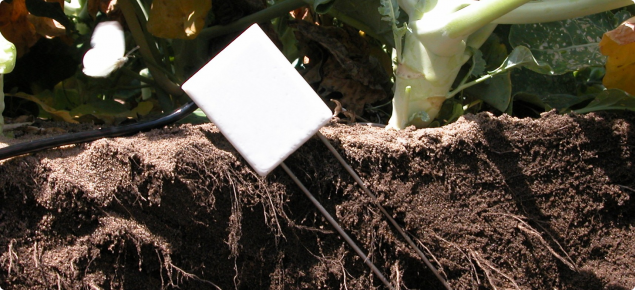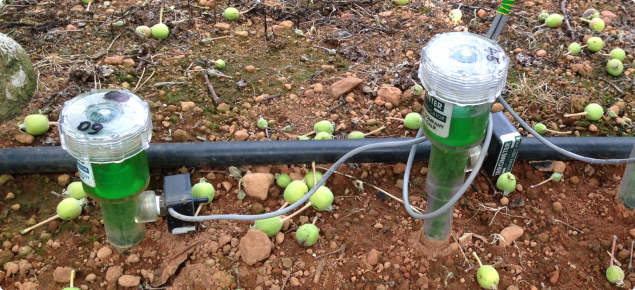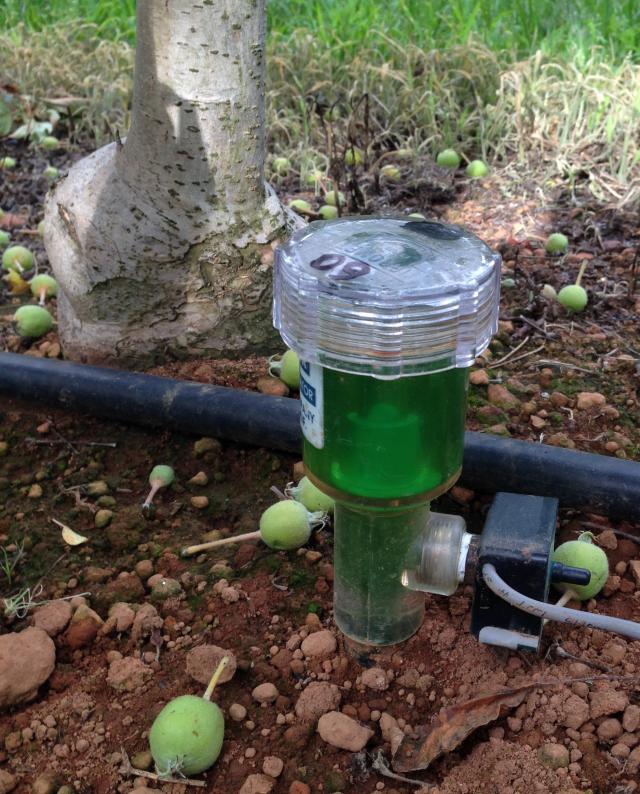Scheduling irrigation
To be used effectively, soil moisture sensors must be:
- used in an irrigation shift that delivers water evenly
- installed correctly and placed in an area which is representative of the crop being grown
- used in combination with other irrigation management information (soil moisture sensors only measure a tiny area of an irrigation shift):
- evaporation-based scheduling
- soil moisture monitoring
- grower observation.
Sensor types
There are basically two groups of sensors:
- water potential sensors, such as tensiometers and granular matrix sensors
- soil moisture sensors that give a percentage or relative content of soil moisture.
Water potential sensors
These sensors measure how hard it is to remove water from the soil, providing the best indication of available water for plants. Soil type and water content influence the suction pressure required to remove water from the soil, but a monitored sensor, which is recorded and graphed, will show the sharp fall that indicates water has become hard for a plant to access.
Questions when choosing a water potential sensor:
- Do they accurately read in the desired range for the crop in which they are used?
- Do they react quickly enough to be useful for the crop being monitored?
The two most common types of water potential sensors are tensiometers and granular matrix sensors, such as gypsum block and watermark sensors.
Tensiometer sensors
Tensiometers (Figure 1) are the most responsive water potential sensor, and they require the most care and maintenance. There are two types of tensiometer tip: one is used in sands, and the other in clays and loams. Use the appropriate tip to see quick reactions to changes in water status.
Tensiometers work by measuring suction pressure at the tensiometer's porous tip. Water is drawn out of or into the tip, depending on water availability. This creates a suction pressure representing the suction force required for a plant to obtain water from the soil. Measurements can be done by manually reading a vacuum gauge, or automatically, using a logging pressure transducer.
To maintain tensiometers, check for bubbles and refill the fluid used to create the vacuum within the tensiometer.
Granular matrix sensors
Granular matrix sensors pass a current across a porous media – usually gypsum – with the electrical resistance changing proportionally to the amount of water drawn in and out of the media. They are generally a low cost, low maintenance sensor. Once installed they often last many years without intervention.
The reactivity of granular matrix sensors to changes in water status is the biggest limitation to their use. Accuracy is somewhat poor and can vary greatly – between 10% and 25% of the actual measurement.
Most granular matrix sensors have low accuracy at low tension (0–10 kilopascals). This is an issue if the soil type being measured has limited plant available water and the crop is water sensitive, such as vegetables grown on the coarse WA sands and heavier clays.
Depending on the porous material and the construction of the sensor, the water seems to move in and out of these sensors slower than with tensiometers. There tends to be a lag in the sensor wetting and drying in response to the soil. The lag tends to be greater as the soil dries, as opposed to rewetting, and therefore may lead to an underestimation of plant stress on the drying cycle.
Water content sensors
These sensors measure the water content of a soil using the time or frequency of a pulse travelling between or returning to electrodes. The most common types are capacitance and time or frequency domain. Most sensors are accurate within 2–3% of the actual soil moisture.
Capacitance sensors
Capacitance sensors generally measure several depths at intervals of 10 to 20cm, and come in lengths from 40 to 180cm. Multiple depth measurement produces useful information on water movement through the soil profile and relative moisture content of the soil at different depths.
The limitation with most capacitance sensors is that they measure only a very small volume of soil outside the access tube or wall of the sensor. Correct installation must maximise soil contact and ensure water is not allowed to move preferentially down the outside of the sensor. If this occurs, the measurements will not reflect the situation in the undisturbed soil away from the sensor. The method of measurement means these sensors are affected by salts in the soil: salts increase electrical conductivity which means the sensor inaccurately overestimates soil moisture.
Time and frequency domain sensors
True time domain reflectometry (TDR) sensors are very accurate, but require quite complex and expensive measurement equipment. A similar, less expensive alternative are sensors that measure using water content reflectometry (WCR) and time domain transmissometry (TDT).
This type of sensor generally consists of two or three metal prongs between 5 and 30cm long that are pushed into the side of a soil pit to measure the undisturbed soil. The measurement extends to about 3 to 6cm around the sensor, giving a larger volume of soil measured (0.3 to 8L).
With correct installation into undisturbed soil and the larger volume of soil being measured, data from these sensors will be more representative of the whole area compared to capacitance sensors. They are also less affected by salts in the soil.
Accurate estimation of water availability with time or frequency and capacitance sensors will only be achieved by calibration with soil tension measurements. If calibration is not done, estimation of water availability relies on interpretation of the change in curve produced by taking regular measurements and graphing them.
Choosing a sensor for your farm
Choosing a soil moisture monitoring system can be difficult. Systems that deliver data to a website or your local computer are readily available and are a better option than a manually read sensor.
The following questions may help assess the suitability of a system for your farm:
- Are you more concerned with available water (water potential) or the movement of water in the soil?
- Do the sensors react well in the soil type and range of soil water in which the crops are being grown?
- Is accuracy important? How sensitive is the crop being monitored? Will a delay in identifying the lower level of soil moisture and stress point result in yield loss?
- Are you prepared to maintain sensors (e.g. check for air in tensiometers)?
- Are the graphs or values easily understood and is support available to interpret the data from the system?
- Is the system adaptable? If you change your mind about the type of sensor you want, will your logger take different probes?
- Does the information automatically log to a computer system or does it have to be manually read?
- If the system is web based, is the site reliable so you can depend on data being available when needed?
| Soil and crop type | Tensiometer | Granular matrix | Gypsum block |
|---|---|---|---|
| Soil type | |||
| Coarse sand | Yes | No | No |
| Sandy loam, loam, loamy clay | Yes | Yes | Yes |
| Heavy clay | Yes | Yes | Yes |
| Crop type |
|
|
|
| Vegetables and strawberries | Yes | No | No |
| Perennial fruit and table grapes | Yes | Yes | No |
| Pastures | Yes | Yes | yes |
| Wine grapes | No | No | Yes |
| Maintenance required | Moderate | Low or none | Low or none |
| Sensor type | Cost range ($) |
|---|---|
| Granular matrix | 50–400 |
| Gypsum block | 80–150 |
| Manual tensiometers | 100–400 |
| Logging tensiometers | 400–700 |
| Auto-refill tensiometers | 1000–1500 |
Many farmers may have purchased and previously used manual tensiometers. Many of these can be retrofitted with pressure transducers and can be logged using commercial computer packages.
If soil moisture or capacitance sensors are preferred, the shape and pattern of data measured is most important. Base the purchase of these types of probes on the following criteria:
- Copes with salinity: Is the probe likely to be affected by salts in the soil and does the probe still work in these conditions?
- Repeatability: Will the reading be the same if soil moisture has not changed so graphs will be clear and simple?
- Volume of soil measured: What volume of soil is the probe measuring? Is a larger volume desirable?
- Temperature and salinity measures: Some soil moisture probes also measure temperature and electrical conductivity so would these be useful to track?
- Ease of installation: What assistance is there to ensure proper installation, such as an instruction manual, video or demonstration?
- Robustness: How robust are the probes? Are they likely to be damaged and can they be easily repaired?
Summary
Selecting the correct soil moisture probe will provide useful information for your irrigation management.
Crop water sensitivity and soil type should guide your purchase, unless you want a system that measures soil moisture content and plant available water.
Remember that soil monitoring is just one tool to assist irrigation scheduling. Other steps to deliver the best irrigation outcome for your crop include using evaporation or evapotranspiration as a reference, knowing your soil type and crop, and using good irrigation design to deliver water evenly.




